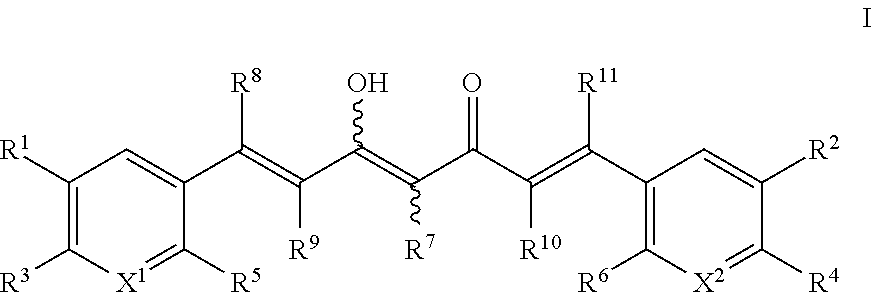Derivatives of dimethylcurcumin
a technology of dimethylcurcumin and derivatives, applied in the field of dimethylcurcumin derivatives, can solve the problems of poor absorption, distribution, metabolism and/or excretion (adme) properties, and the wide use of many current medicines
- Summary
- Abstract
- Description
- Claims
- Application Information
AI Technical Summary
Problems solved by technology
Method used
Image
Examples
example 1
Synthesis of (1E,4Z,6E)-1,7-bis(3,4-bis(trideuteromethoxy)phenyl)-5-hydroxyhepta-1,4,6-trien-3-one (Compound 212)
[0140]
[0141]Step 1. 3,4-bis(trideuteromethoxy)benzaldehyde (10a): To a suspension of 3,4-dihydroxybenzaldehyde (8, 5.0 g, 36.2 mmol) in acetonitrile (120 mL), was added potassium carbonate (15.0 g, 108.6 mmol). The mixture was stirred vigorously at ambient temperature for 15 minutes. To this reaction mixture was added iodomethane-d3 (7.2 mL, 115.84 mmol; Aldrich, 99.5 atom % D) and then the mixture was heated to 45° C. for a period of 15 hours. The mixture was then cooled to ambient temperature, filtered through Celite®, and concentrated in vacuo. The crude residue was diluted with EtOAc (100 mL) and water (100 mL) and the resulting aqueous layer was further extracted with EtOAc (3×20 mL). The combined organic layers were washed with 10% aqueous Na2CO3 (2×20 mL), dried (MgSO4), filtered, and concentrated in vacuo to afford aldehyde 10a (5.2 g, 83%). MS (M+H): 173.2.
[0142]...
example 2
Synthesis of (1E,4Z,6E)-5-hydroxy-1,7-bis(3-methoxy-4-(trideuteromethoxy)phenyl)hepta-1,4,6-trien-3-one (Compound 214)
[0143]
[0144]Step 1. 3-methoxy-4-(trideuteromethoxy)benzaldehyde (10c): To a suspension of vanillin (9, 5.0 g, 32.9 mmol) in acetonitrile (110 mL), was added potassium carbonate (6.8 g, 49.3 mmol). The mixture was stirred vigorously at ambient temperature for 15 minutes. To this reaction mixture was added iodomethane-d3 (3.3 mL, 52.6 mmol; Aldrich, 99.5 atom % D) and then the mixture was heated to 45° C. for a period of 15 hours. The mixture was then cooled to ambient temperature, filtered through Celite®, and concentrated in vacuo. The crude residue was diluted with EtOAc (100 mL) and water (100 mL) and the resulting aqueous layer was further extracted with EtOAc (3×20 mL). The combined organic layers were washed with 10% aqueous Na2CO3 (2×20 mL), dried (MgSO4), filtered, and concentrated in vacuo to afford aldehyde 10c (5.0 g, 90%). MS (M+H): 170.2.
[0145]Step 2. (1E...
example 3
Synthesis of (1E,4Z,6E)-1,7-bis(3,4-bis(trideuteromethoxy)phenyl)-1,2,6,7-tetradeutero-5-hydroxyhepta-1,4,6-trien-3-one (Compound 215)
[0146]
[0147]Step 1. Methyl 3,4-bis(trideuteromethoxy)benzoate (15): To a suspension of commercially available methyl 3,4-dihydroxybenzoate (14, 2.0 g, 11.89 mmol) in acetonitrile (50 mL), was added potassium carbonate (4.9 g, 35.67 mmol). The mixture was stirred vigorously at ambient temperature for 15 minutes. To this reaction mixture was added iodomethane-d3 (2.4 mL, 38.06 mmol; Aldrich, 99.5 atom % D) and then the mixture was heated to 45° C. for a period of 15 hours. The mixture was then cooled to ambient temperature, filtered through Celite®, and concentrated in vacuo. The crude residue was diluted with EtOAc (100 mL) and water (100 mL) and the resulting aqueous layer was further extracted with EtOAc (3×20 mL). The combined organic layers were washed with 10% aqueous Na2CO3 (2×20 mL), dried (MgSO4), filtered, and concentrated in vacuo to afford e...
PUM
| Property | Measurement | Unit |
|---|---|---|
| temperature | aaaaa | aaaaa |
| temperature | aaaaa | aaaaa |
| temperature | aaaaa | aaaaa |
Abstract
Description
Claims
Application Information
 Login to View More
Login to View More - R&D
- Intellectual Property
- Life Sciences
- Materials
- Tech Scout
- Unparalleled Data Quality
- Higher Quality Content
- 60% Fewer Hallucinations
Browse by: Latest US Patents, China's latest patents, Technical Efficacy Thesaurus, Application Domain, Technology Topic, Popular Technical Reports.
© 2025 PatSnap. All rights reserved.Legal|Privacy policy|Modern Slavery Act Transparency Statement|Sitemap|About US| Contact US: help@patsnap.com



